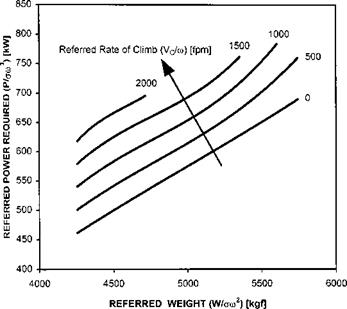General test conditions and methodology
Tests are normally planned to allow the widest possible range of referred AUM and generally start at maximum altitude and high AUM (maximum fuel and ballast) and progress to a ‘light and low’ condition via a descending series of hovers. It may be advantageous to have the aircraft cleared to operate at an overload weight for the purposes of these tests. The presence of external stores and/or the operation of movable aerodynamic surfaces may influence vertical performance. Where this is the case, a range of configurations should be tested at a number of nominal atmospheric conditions. Centre of gravity (CG) position is not usually critical to vertical perfor-
|
Fig. 3.22 Referred vertical climb test data – MPV method. |
|
Fig. 3.23 Smoothed vertical climb data. |
mance and so a nominal mid-position is normally chosen. The use of airbleeds will reduce the available engine power and consequently the performance of the aircraft when engine-limited. Most testing is conducted with airbleeds OFF but comparative tests with various combinations of heaters, anti-ice and other significant electrical loading may be required. Inside ground effect (IGE) hover points should be flown at a variety of wheel/skid heights to determine the magnitude of ground effect and the IGE/OGE boundary. Rotor speed may be adjusted within the continuous power-on range in order to maintain m/V0 at the desired value. For vertical performance testing, the effect of relative humidity (RH) is usually ignored. However, if the aircraft is required to operate in hot conditions it may be necessary to account for it. For example, at 30°C and sea level, 100% RH makes the true DA about 1000 ft higher than that calculated from Hp and OAT alone.
If only one test site is available, the range of referred weights attainable will be restricted by the local ambient conditions, although seasonal variations may be exploited on a long test programme. A comprehensive performance trial will normally be conducted in temperate conditions and then supplemented by further testing in hot and high conditions. Additionally data may be recorded during ice and snow trials. IGE tests are further restricted by the actual elevation of the test site(s). The necessity to conduct ground-referenced IGE tests at high elevation and in a wide range of temperatures often entails testing at a remote site with a commensurate increase in the flight time budget. Careful planning may be required to achieve the maximum possible referred weight range within the constraints of limited engine performance. It may be necessary to fly ‘very heavy and low’ rather than ‘heavy and high’ for a particular condition due to the engine’s inability to produce sufficient power at high altitude.
Since the advance ratio is zero in the hover, it is unlikely that there will be significant compressibility effects in most hover conditions unless the ambient temperature is very low and/or the altitude is high. At high thrust coefficients, however, the drag rise Mach number at the blade tip may be sufficiently low to cause a significant increase in drag and thus of power required. Equally, there may be local blade stalling which will contribute to an overall increase in power over and above that predicted by simple theory. Tip effects (TE) are rarely significant except in the case of a dramatic increase in the operational weight or significant change to the theatre of operations. It may be possible, therefore, to reduce the total amount of testing by conducting specific tests designed to expose these effects. Tip effects are most evident when high m/^0 (high Nr and low OAT) is combined with a high AUM. The widest possible OAT range is therefore required for TE testing and this is most easily achieved by hovering at different altitudes. For rotorcraft with fixed NR, test conduct becomes problematic since, for a given atmospheric condition, there will be a unique relation between 0 and a. Thus, for any given value of W/am2 the only parameter that can be varied independently is the all-up-mass (W). Consequently, a considerable number of changes in mass and a succession of climbs and descents will be required to obtain data for a range of referred rotor speeds at the desired referred weights. If specific testing shows that TE are insignificant, subsequent performance testing may be accelerated by changing rotor speed to increase the available range of Wlam2 for a given ambient condition and ignoring the effect of ambient temperature on blade tip Mach number.
3.5.3 Flight test techniques













